164 - Video-Assisted Thoracic Surgery for Mediastinal Tumors and Cysts and Other Diseases Within the Mediastinum
Editors: Shields, Thomas W.; LoCicero, Joseph; Ponn, Ronald B.; Rusch, Valerie W.
Title: General Thoracic Surgery, 6th Edition
Copyright 2005 Lippincott Williams & Wilkins
> Table of Contents > Volume II > The Mediastinum > Section XXX - Mediastinal Cysts > Chapter 194 - Foregut Cysts of the Mediastinum in Children and in Adults
Chapter 194
Foregut Cysts of the Mediastinum in Children and in Adults
Marleta Reynolds
Foregut cysts account for 11% to 18% of mediastinal masses in infants and children, as reported by Meza and associates (1993). The more common bronchogenic cysts and enteric cysts are reported by Gray and Skandalakis (1972) to arise from the primitive foregut in the region of the laryngotracheal groove before its differentiation into the trachea and esophagus. The report of Nobuhara and colleagues (1997) agrees that a common origin of these two entities exists, but these cysts and duplications are most often discussed separately.
Sulzer and associates (1970), in reviewing 40 of these cysts in all age groups, found that two thirds of the cysts were located in the upper half of the mediastinum and were most often associated with the trachea or the tracheal bifurcation. In the lower half of the mediastinum, the lesions were associated with the esophagus. In a review, Snyder and associates (1985) described 34 infants and children with mediastinal foregut cysts; the location of these cysts is shown in Fig. 194-1. Twenty-three children had bronchogenic cysts, and 11 had enteric cysts. Twelve children were asymptomatic. Most of the others developed symptoms related to the location of the cyst and presented with symptoms of pneumonia, major airway obstruction, or esophageal obstruction (Table 194-1). Other foregut derivatives, gastroenteric cysts, and neuroenteric cysts are discussed in Chapters 149 and 196.
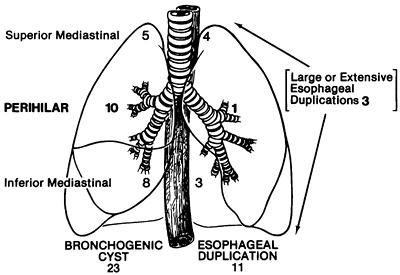 |
Fig. 194-1. Location of foregut cysts of the mediastinum in 34 infants and children. From Snyder ME, et al: Diagnostic dilemmas of mediastinal cysts. J Pediatr Surg 20:810, 1985. With permission. |
BRONCHOGENIC CYSTS
A number of excellent reports of bronchogenic cysts in infants and children have been published by DiLorenzo (1989), Koskas (1992), Suen (1993), Hoeffel (1994), Ribet (1995), and Nobuhara (1997) and their associates. A few of these reports also included adult patients, as well as bronchogenic cysts that have occurred in the lung, which I have discussed in Chapter 80. Of some interest is that bronchogenic cysts may likewise be found in other areas of the body. More than 40 examples of subcutaneous bronchogenic
P.2824
cysts have been described by numerous researchers, including van der Putte and Toonstra (1985) and Jona (1995). Such cysts are most often found in the suprasternal area, but other sites, such as the scapular region, have been involved. The occurrence of a transdiaphragmatic, dumbbell bronchogenic cyst has been reported by Amendola and coinvestigators (1982), and Coselli and associates (1987) reported a rare instance of a bronchogenic cyst located below the diaphragm. Other locations recorded have been intrapericardial, intrathymic, and the anterolateral surface of a thoracic vertebral body (paravertebral sulcus), as noted in the report of Suen and colleagues (1993). Hoeffel (1994) and Ribet (1995) and their associates also recorded bronchogenic cysts located in the paravertebral sulcus. DiLorenzo and associates (1989) reported two cysts within the pulmonary ligament in their series of 26 patients.
Table 194-1. Mediastinal Foregut Cysts: Clinical Presentation in 34 Children | ||||||||||||||||||||||||||||||
|---|---|---|---|---|---|---|---|---|---|---|---|---|---|---|---|---|---|---|---|---|---|---|---|---|---|---|---|---|---|---|
|
Pathology
Bronchogenic cysts are formed by epithelial cells that become separated from the developing tracheobronchial tree. Luck and associates (1986) reported that on histologic examination bronchogenic cysts are lined by pseudostratified ciliated columnar or cuboidal epithelium on a base of fibrous tissue and smooth muscle. In some areas, the epithelial lining may be denuded or replaced by squamous metaplasia. The cyst wall may contain isolated islands of cartilage and bronchial mucous glands. If associated inflammation with destruction of the cyst lining exists, it may be difficult to determine the exact origin of the cyst. The cysts are usually singular and unilocular, although multiple and multilocular cysts have been reported by Ramenofsky and associates (1979). Clear or hemorrhagic fluid, mucus, or purulent material may fill the cyst.
Although a bronchogenic cyst is a benign cystic lesion, a small number of cases are reported to have been associated with a malignant tumor. Krous and Sexauer (1981) reported the occurrence of an embryonal rhabdomyosarcoma arising in a congenital bronchogenic cyst of the lung in a 2 -year-old girl; Suen and associates (1993) reported an adenocarcinoma that developed in a subcarinal bronchogenic cyst in an 8 -year-old girl; and Cuypers and colleagues (1996) recorded a cyst in which a squamous cell carcinoma had occurred. Other malignant lesions associated with bronchogenic cysts have been recorded, many of which, however, involved intrapulmonary bronchogenic cysts.
Clinical Presentation
Children with mediastinal bronchogenic cysts can present at any age with nonspecific respiratory symptoms or dysphagia. There may be a history of fever and recurrent pneumonia. Infants may present with signs of major airway obstruction (e.g., wheeze, stridor, or cough) that may be rapidly progressive. Asymptomatic cysts may be present in 20% to 30% of the cases, as noted in the series reported by Nobuhara (1997), Ribet (1995), and DiLorenzo (1989) and their colleagues. The physical examination in these patients may be entirely normal. However, in symptomatic patients physical examination may reveal decreased breast sounds on the affected side with signs of mediastinal shift to the opposite side.
Radiologic Investigation
Standard Radiography
A cyst (mass) located in the visceral compartment of the mediastinum is identified on a routine chest radiography in an asymptomatic patient. In the infant or child with one or more of the aforementioned symptoms, however, the initial radiologic examination should include a chest radiograph; the lateral view is often of the most value. Most often the cyst is filled entirely with fluid and appears as a radiopaque mass. Cysts that compress the adjacent trachea or bronchus may lead to unilateral air trapping and mediastinal shift (Fig. 194-2). Occasionally a cyst may be filled with air, and the chest radiograph shows a well-defined, radiolucent, spheric, or oval lesion (Fig. 194-3). A communication with the tracheobronchial tree may act as a ball valve; under these circumstances, the cysts may reach considerable size and result in a shift of the mediastinum.
P.2825
Herrmann and colleagues (1959) reported a child who developed a tension pneumothorax after rupture of a bronchogenic cyst. If only a small amount of air is in the cyst, a decubitus or upright radiograph of the chest may show the air-fluid interface. If infection occurs as the result of an airway communication, the lesion may be suspected initially of being a lung abscess.
 |
Fig. 194-2. Anteroposterior chest radiograph of an infant with a subcarinal bronchogenic cyst resulting in obstruction of the left main bronchus with air trapping in the left lung and a shift of the mediastinum to the right. |
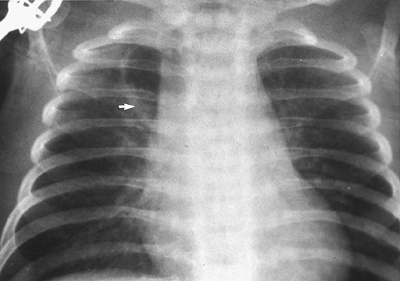 |
Fig. 194-3. Anteroposterior radiograph of the chest of an infant with a large bronchogenic cyst on the right filled with air after aspiration and infusion of air into the cyst. Arrow marks the cyst wall. |
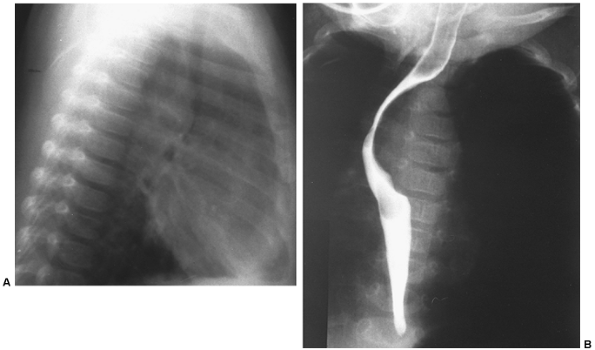 |
Fig. 194-4. A. Lateral chest radiograph shows deviation of the trachea anteriorly and displacement of the esophagus posteriorly with a dilated segment above the compressing mass. B. Barium esophagram shows marked deviation and extrinsic compression of the esophagus by a bronchogenic cyst. Same patient as shown in Fig. 194-2. |
Computed Tomography and Magnetic Resonance Imaging
Contrast-enhanced computed tomography (CT) of the chest has replaced the barium esophagram in the evaluation of infants with unexplained stridor with or without abnormal chest radiographic results (Figs. 194-4, 194-5, 194-6). In a review by Snyder and associates (1985), chest CT was diagnostic in 14 of 15 patients in whom the study was obtained. Lazar and associates (1991) reported 100% diagnostic accuracy with chest CT. The cyst, on occasion, may have the CT characteristics of a solid lesion. Magnetic resonance (MR) imaging is probably as accurate as CT and avoids radiation exposure. In infants and small children, the risks of sedation for magnetic resonance imaging must be weighed against the radiation exposure of CT imaging.
Antenatal Ultrasonography
In the late 1980s and in the 1990s, the use of prenatal ultrasonography identified an increasing number of pulmonary malformations and mediastinal abnormalities. Vergnes and associates (1989) reported the diagnosis of nine cases of lung malformations, one of which was a bronchogenic cyst. Hoeffel (1994) recorded the prenatal sonographic identification of a number of mediastinal bronchogenic cysts. Winters and Effmann (2001) emphasized that serial
P.2826
P.2827
prenatal imaging was important in confirming diagnosis. Postnatal radiography and CT are critical to make appropriate management decisions.
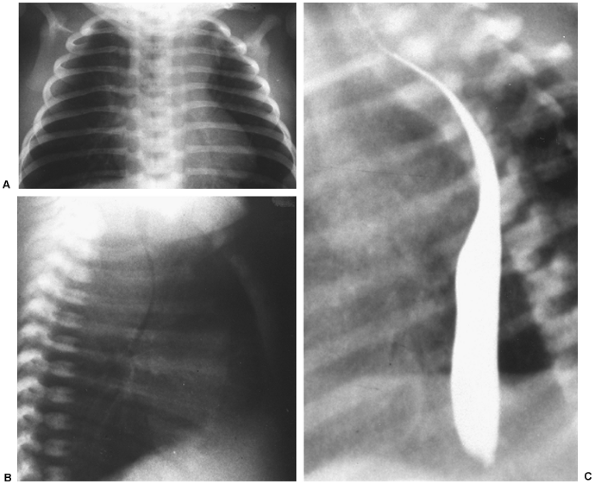 |
Fig. 194-5. A, B. Anteroposterior and lateral radiographs of the chest of an infant with nonspecific respiratory symptoms reveal an ill-defined mass in the superior portion of the left chest on the anteroposterior radiograph and forward displacement of the trachea in the lateral radiograph. C. Barium esophagram confirmed deviation of the esophagus. Resection of a large bronchogenic cyst was accomplished without difficulty. |
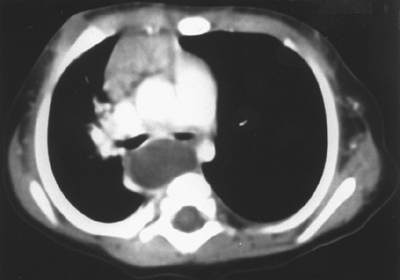 |
Fig. 194-6. CT scan reveals a bronchogenic cyst located in the subcarinal area with compression of the left main-stem bronchus with hyperinflation of the left lung and a mediastinal shift to the right in the patient shown in Fig. 194-2. |
Treatment
Surgical excision is recommended for all bronchogenic cysts. The operative intervention may be emergent, urgent, or elective depending on the clinical presentation of the patient. Prompt intervention is mandatory in the infant with severe respiratory distress. In the newborn in whom a cyst has been discovered by antenatal sonography, early removal before serious complications occur is recommended. Through a right thoracotomy, the cyst can be teased from the adjacent trachea or bronchus. Occasionally the wall of the cyst is impossible to dissect free from the membranous portion of the trachea or bronchus. The cyst can be opened and the mucosa stripped from the wall of the cyst. Recurrence is less likely if the mucosal lining is removed. Read and associates (1991) described a patient who developed a recurrent bronchogenic cyst 25 years after initial resection. The trachea can be patched with pericardium if a portion of the membranous trachea is removed with the cyst. Birmingham and colleagues (1993) reported on the anesthetic management of 24 children with bronchogenic cysts. Positive-pressure ventilation and nitrous oxide were used in most of the cases without complications. In infants with marked respiratory distress from obstruction of the airway, Kleeman and associates (1987) have described the use of an ultrathin bronchoscope in the management of this difficult problem. Monrigal and Granry (1996) have used an ultrathin fiberoptic bronchoscope to monitor the progress and adequacy of anesthetic management and oxygenation during the excision of a bronchogenic cyst causing severe airway obstruction in an 8-day-old infant girl and a 4-month-old boy.
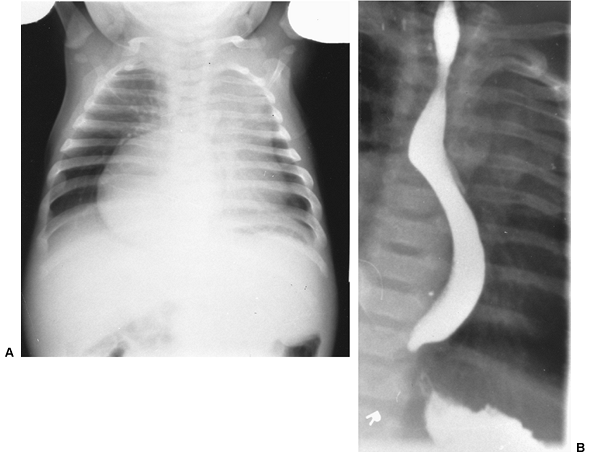 |
Fig. 194-7. A. Anteroposterior chest radiograph of an infant with a mass in the lower half of the right hemithorax. B. Barium esophagram revealed deviation of the esophagus to the right. Exploration revealed an enteric cyst attached to the wall of the esophagus. |
P.2828
Rodgers and colleagues (1992) reported thoracoscopic resection of a bronchogenic cyst in two children, with complications developing in one child. Martinod and associates (2000) reported a combined series of children and adults who had undergone thoracoscopic resection of mediastinal bronchogenic cysts. Preoperative complications, intraoperative injuries, and major adhesions to vital structures were three conditions that predicted conversion to an open procedure. Although minimally invasive techniques can be used to successfully remove mediastinal bronchogenic cysts, the patients must be selected carefully, and conversion to the open technique considered early if complications arise.
All tissue from resection of a bronchogenic cyst should be submitted to pathology. A more extensive resection and reconstruction may be necessary if malignancy is discovered.
ENTERIC CYSTS
Enteric cysts have been referred to as dorsal enteric cysts, esophageal duplications, or enterogenous cysts. Gray and Skandalakis (1972) reported that enteric cysts originate from the foregut during the second week of gestation and can be lined with epithelium derived from either the alimentary tract or the respiratory tract. Two or three mucosal types can coexist in a single cyst. Muscle and cartilage also can be present in the cyst wall. When cartilage is present, however, most authorities believe that the cyst is bronchogenic in origin.
Most enteric cysts are found associated with the esophagus in the middle or lower thirds of the visceral compartment of the mediastinum. The muscle layer of the cyst may be continuous with that of the normal esophagus or be completely separate. Occasionally a communication between the esophagus and the cyst is present.
Infants and children with enteric cysts may be asymptomatic. They also may present with signs of esophageal obstruction. A large cyst may compress adjacent lung parenchyma, and the child may present with pneumonia. If the cyst contains gastric mucosa, peptic ulceration with bleeding into the cyst or perforation of the cyst may occur.
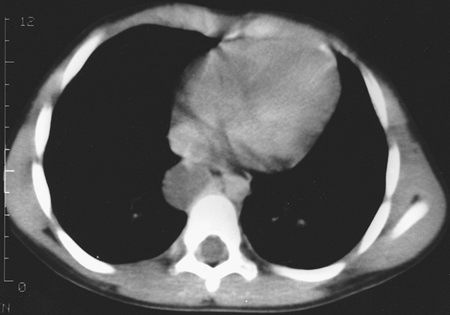 |
Fig. 194-8. CT scan of a paraesophageal enteric cyst. The mucosal layer only is present between the cyst and lumen of the esophagus. |
Diagnosis
In the asymptomatic child, the cyst is usually identified on a routine chest radiograph obtained for an unrelated reason. The radiograph of the chest shows a spheric or oval mass in the visceral compartment of the mediastinum, usually on the right side, and may project into the paravertebral sulcus. A barium esophagram outlines the cyst (Fig. 194-7). CT scan has replaced the esophagram as the diagnostic imaging modality of choice because it can better differentiate this lesion from other masses of the mediastinum (Fig. 194-8).
Treatment
Resection of an enteric cyst is approached by posterolateral thoracotomy or thoracoscopy. The cyst must be completely removed to avoid recurrence. If the cyst has a common wall with the esophagus, the cyst can be opened, the mucosa stripped away, and the wall closed (Fig. 194-9). Dillon and associates (1993) reported successful resection of an enteric cyst in a 2-year-old girl using the video-assisted technique. Immediate and long-term results should be excellent if there has not been a delay in diagnosis with resulting complications.
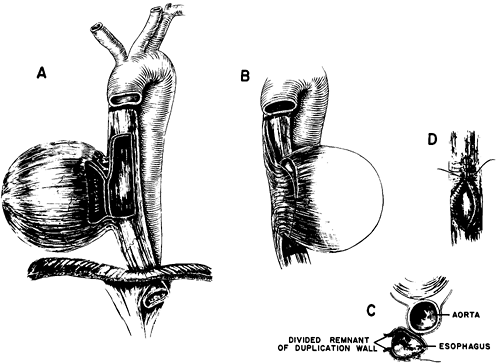 |
Fig. 194-9. A D. The most common form of enteric duplication (enteric cyst) within the mediastinum is a cystic lesion encompassed within the muscular layers of the esophagus (A). The technique for excision is to remove only the mucosa in the portion of the cyst adjacent to the esophagus (B) so that the remaining muscular wall (C) can be used to close over the bare area of the remaining esophageal mucosa (D). From Raffensperger J (ed): Pediatric Surgery. Norwalk, CT: Appleton-Century-Crofts, 1980. With permission. |
P.2829
REFERENCES
Amendola MA, et al: Transdiaphragmatic bronchopulmonary foregut anomaly. Dumbbell bronchogenic cyst. AJR 138:1165, 1982.
Birmingham PK, Uejima T, Luck SR: Anesthetic management of the patient with a bronchogenic cyst: a review of 24 cases. Anesth Analg 78:879, 1993.
Coselli MP, et al: Bronchogenic cysts above and below the diaphragm: report of eight cases. Ann Thorac Surg 44:491, 1987.
Cuypers P, et al: Bronchogenic cysts: a review of 20 cases. Eur J Cardiothorac Surg 10:393, 1996.
Dillon PW, Cilley RE, Krummel TM: Video-assisted thoracoscopic excision of intrathoracic masses in children: report of two cases. Surg Laparosc Endosc 3:433, 1993.
DiLorenzo M, et al: Bronchogenic cysts. J Pediatr Surg 24:988, 1989.
Gray SW, Skandalakis JE: Embryology for Surgeons. Philadelphia: WB Saunders, 1972.
Herrmann JW, Jewett TC, Galletti G: Bronchogenic cysts in infants and children. J Thorac Surg 37:242, 1959.
Hoeffel JC, et al: L'imagerie des kystes bronchog nique chez l'enfant. Ann Radiol 37:417, 1994.
Jona JZ: Extramediastinal bronchogenic cysts in children. Pediatr Dermatol 12:304, 1995.
Kleeman P-P, Jantzen J-PAH, Bonfils P: The ultra-thin bronchoscope in management of the difficult paediatric airway. Can J Anaesth 34:606, 1987.
Koskas M, et al: Kystes bronchog niques de la car ne [Bronchogenic cysts in the carina]. Rev Mal Respir 9:509, 1992.
Krous HK, Sexauer CL: Embryonal rhabdomyosarcoma arising within a congenital bronchogenic cyst in a child. J Pediatr Surg 16:506, 1981.
Lazar RH, Younis RT, Bassila MN: Bronchogenic cysts: a cause of stridor in the neonate. Am J Otolaryngol 12:117, 1991.
Luck SR, Reynolds M, Raffensperger JG: Congenital bronchopulmonary malformations. Curr Probl Surg 23:245, 1986.
Martinod E, et al: Thoracoscopic excision of mediastinal bronchogenic cysts: results in 20 cases. Ann Thorac Surg 69:1525, 2000.
Meza MP, Benson M, Slovis T: Imaging of mediastinal masses in children. Radiol Clin North Am 31:583, 1993.
Monrigal J-P, Granry J-C: Excision of bronchogenic cysts in children using an ultrathin fibreoptic bronchoscope. Can J Anaesth 43:694, 1996.
Nobuhara KK, et al: Bronchogenic cysts and esophageal duplications: common origins and treatment. J Pediatr Surg 32:1408, 1997.
Raffensperger J (ed): Pediatric Surgery. Norwalk, CT: Appleton-Century-Crofts, 1980.
Ramenofsky ML, Leape LL, McCauley RGK: Bronchogenic cyst. J Pediatr Surg 14:219, 1979.
Read CA, et al: Recurrent bronchogenic cyst. An argument for complete surgical excision. Arch Surg 126:1306, 1991.
Ribet ME, Copin MC, Gosselin B: Bronchogenic cysts of the mediastinum. J Thorac Cardiovasc Surg 109:1003, 1995.
Rodgers DA, et al: Thoracoscopy in children: an initial experience with an evolving technique. J Laparoendosc Surg 2:7, 1992.
Snyder ME, et al: Diagnostic dilemmas of mediastinal cysts. J Pediatr Surg 20:810, 1985.
Suen HC, et al: Surgical management and radiological characteristics of bronchogenic cysts. Ann Thorac Surg 55:476, 1993.
Sulzer J, et al: Forty cases of bronchogenic cysts of the mediastinum [in French]. Ann Chir Thorac Cardiovasc 9:261, 1970.
van der Putte SC, Toonstra J: Cutaneous bronchogenic cyst. J Cutan Pathol 12:404, 1985.
Vergnes P, et al: Antenatal diagnosis of lung malformations. Apropos of 9 case reports [in French]. Chir Pediatr 30:185, 1989.
Winters WD, Effmann EL: Congenital masses of the lung: prenatal and postnatal imaging evaluation. J Thorac Imaging 16:196, 2001.
EAN: 2147483647
Pages: 203